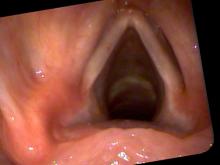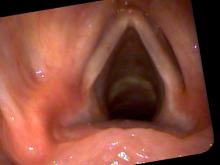Non-organic dyspnea
Non-organic dyspnea occurs when the vocal cords vibrate during breathing. A non-organic disorder can mimic almost any organic disorder. In the case of non-organic dyspnea this tends to mimic asthma.
I see this disorder most frequently in young female athletes although anyone may acquire this disorder. It goes by other common names such as paradoxical vocal cord motion. The implication of this name is that the vocal cords are moving in the opposite direction that they should. That is, they are moving closer together during breathing in rather than moving farther apart.
Typically the individual is very athletic and during some athletic event they suddenly develop stridor or noisy breathing. Surrounding individuals may be quite concerned. 911 may be called or the person may even end up in the emergency room. However all testing will be found to be normal. The episode often subsides spontaneously. Sometimes people describe it as a panic attack. The person breathing will notice that it is more difficult to get air in. They may experience difficulty speaking or making sound to speak during the episode.
Other examples include exposure to chemical smells, mold, perfume, smoke or environmental smells that trigger an episode of noisy breathing.
These episodes than become recurrent although the person may be able to continue exercise at a slower pace during the episode.
Quite commonly the individual is treated for asthma with inhalers and steroids. Although they might respond the first time, the treatments are ultimately not successful. Pulmonary function testing particularly with a methacholine challenge is negative for asthma. A close look at pulmonary function testing, especially during an episode, will reveal a truncation of the inspiratory loop. That is, there is a limitation to breathing but it only occurs when breathing in (inspiration) and not when breathing out (expiration).
There is also frequently non-productive treatment for allergies.
The secondary gain might be that the person now has a physical health reason for not winning rather than any lack of skill or commitment. Typically non-organic dyspnea that occurs in the workplace from a smell as the secondary gain of being off work.
Here's an example of a female runner. She had no noise breathing normally. During significant exercise she developed stridor. This was a high-pitched noise that occurred as she breathed in. The noise was coming from her neck rather than her lungs. When I perform an endoscopy while she's making the noise I notice that although the vocal cords are open, the thyroarytenoid muscle (the muscle within the vocal cord) is relaxed and shortened.

As she breathes in deeply and rapidly, Bernoulli effect sucks in the relaxed vocal cords.

The treatment for the disorder can begin during the examination. While the patient is making the noise, if they sniff through their nose, there is a reflex opening of the vocal cords. During a sniff vocal cords open much wider than normal and it is almost impossible to override this reflex.

The person will notice that they get much more air. I typically suggest that they breathe in through their nose and out through their mouth. I believe it helps for them to see the endoscopy and practice breathing both with the noise and without the noise while watching her vocal cords open and close.



